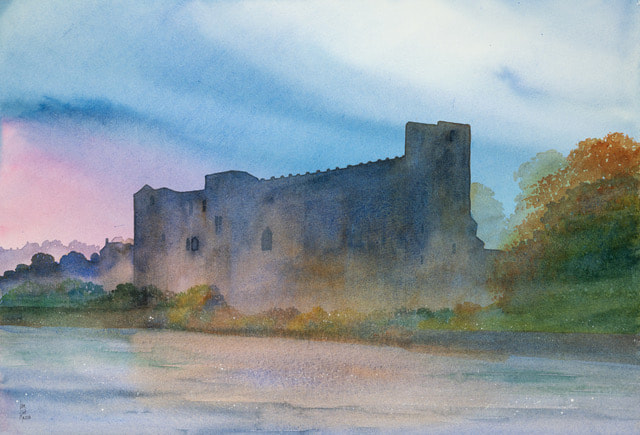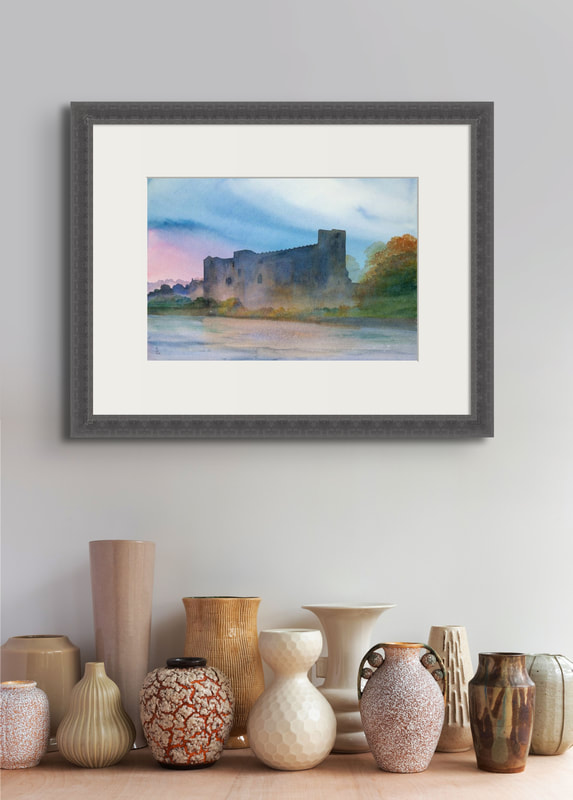Newark Castle by Ian Scott Massie
Original Watercolour
28" x 21" Mounted size - 21" x 14.5" Image size
Available: unframed @ £895
To shop, please click here
28" x 21" Mounted size - 21" x 14.5" Image size
Available: unframed @ £895
To shop, please click here
NEWARK
As A.A.Milne said: “King John was not a good man.” Writing shortly after John’s death the chronicler Matthew Paris went a little further: “tyrant rather than a king”, “John… principal abomination of the English, disgrace to the English nobility” and “Foul as it is, Hell itself is made fouler by the presence of John.”
Newark Castle has a long history: Saxon manor, motte and bailey fort, medieval stronghold. It was here that John died, stricken with dysentery. He wasn’t mourned by many, having broken most of the chivalric rules of the time. He was a sexual predator of wives and daughters and a sadist (he particularly enjoyed starving people to death).
Later, during the Civil War, the castle held out for the Royalists surviving three sieges before surrendering. Given such royal connections one might expect the town to be a bastion of the establishment, but Newark today is home to Britain’s only heathen temple.
The Odinists are named after the chief Norse god and focus on Germanic, Norse and Anglo Saxon myths. The Odinic Rite was founded in 1980 but suffered a schism dividing its members. The Rite took a hard line and the Odinist Fellowship a somewhat softer one. It was the Fellowship who purchased an Elizabethan chapel in 2014 and there they practice rites around a cycle of nine festivals. Some are familiar: Harvest Festival and Yule, while some are less so: Lindisfarne Day and Sigurd’s Day. You’re as likely to encounter the spirits of Thor, Freya and Odin in Newark as the ghosts of departed royals,
Newark has another, railway-based, peculiarity: there are two stations in this small town, a legacy of the undignified scramble of railway mania. Either station might be a good place to pray to any god since the two lines cross at right angles on the same level: one railway passes straight across the tracks of another. Should you ever hear the phrase “Signalling failure at Newark” it might be best to leave the train at the next station.
Newark Castle has a long history: Saxon manor, motte and bailey fort, medieval stronghold. It was here that John died, stricken with dysentery. He wasn’t mourned by many, having broken most of the chivalric rules of the time. He was a sexual predator of wives and daughters and a sadist (he particularly enjoyed starving people to death).
Later, during the Civil War, the castle held out for the Royalists surviving three sieges before surrendering. Given such royal connections one might expect the town to be a bastion of the establishment, but Newark today is home to Britain’s only heathen temple.
The Odinists are named after the chief Norse god and focus on Germanic, Norse and Anglo Saxon myths. The Odinic Rite was founded in 1980 but suffered a schism dividing its members. The Rite took a hard line and the Odinist Fellowship a somewhat softer one. It was the Fellowship who purchased an Elizabethan chapel in 2014 and there they practice rites around a cycle of nine festivals. Some are familiar: Harvest Festival and Yule, while some are less so: Lindisfarne Day and Sigurd’s Day. You’re as likely to encounter the spirits of Thor, Freya and Odin in Newark as the ghosts of departed royals,
Newark has another, railway-based, peculiarity: there are two stations in this small town, a legacy of the undignified scramble of railway mania. Either station might be a good place to pray to any god since the two lines cross at right angles on the same level: one railway passes straight across the tracks of another. Should you ever hear the phrase “Signalling failure at Newark” it might be best to leave the train at the next station.





